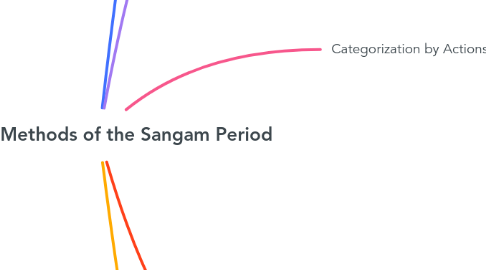
1. Sources of Warfare Knowledge
1.1. Key References
1.1.1. Tholkappiyam Purathinai
1.1.2. Purananuru
1.1.3. Pathitrupathu
1.2. Mention in Akam Literature
1.2.1. Historical accounts as metaphors
2. Types of Warfare (Tholkappiyam)
2.1. Based on Four Key Elements
2.1.1. Cattle
2.1.2. Land
2.1.3. Forts
2.1.4. Battlefields
2.2. Four Types
2.2.1. Vetchi Por: Seizing cattle
2.2.2. Vanji Por: Invading a country
2.2.3. Uzhinjai Por: Besieging forts
2.2.4. Thumbai Por: Engaging in battle
3. Categorization by Actions (Purapporul Venba Malai)
3.1. Vetchi: Seizing cattle
3.2. Karandhai: Retaliation
3.3. Vanji: Invading a country
3.4. Kanji: Countering the enemy
3.5. Uzhinjai: Besieging forts
3.6. Nochchi: Defending forts
3.7. Thumbai: Engaging in battle
3.8. Vaagai: Achieving victory
4. War Strategies
4.1. Techniques to Subjugate the Enemy
4.1.1. Looting enemy territories
4.1.2. Burning enemy fields
4.1.3. Destroying resources and water bodies
4.1.4. Principles of Vanji and Kottravalai
4.2. Techniques to Threaten the Enemy
4.2.1. Thunai Padai Kodal: Kings united against a common enemy
4.2.1.1. Example 1: Seven kings vs. Pandyan Nedunchezhiyan (Battle of Talayalanganam)
4.2.1.2. Example 2: Thirteen kings vs. Chola king Karikalan
4.3. Strategies to Expose the Enemy
4.3.1. Kadimaram Thadithal: Cutting guard trees to provoke honor
4.4. Strategies to Protect the Nation
4.4.1. Offering wealth to form alliances
4.4.2. Surrendering and paying tribute to powerful kings
5. War Ethics
5.1. Ethical Practices
5.1.1. Notify the enemy before invasion (War drums)
5.1.2. Refrain from attacking fleeing enemies
5.1.3. Spare those who surrendered
5.2. Unethical Practices
5.2.1. Greed for land and war atrocities
5.3. Purpose
5.3.1. Avoid unnecessary wars
5.3.2. Protect the nation
5.4. Illustrative Example
5.4.1. Verse from Puram: 9 emphasizes high ethical standards in warfare
